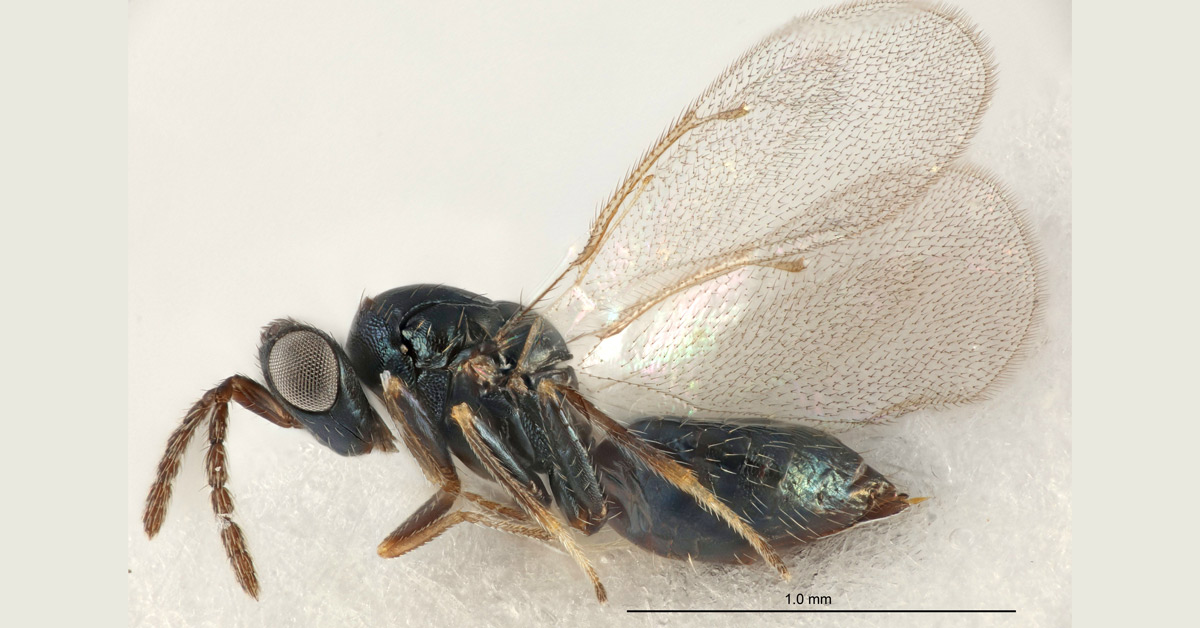
New study adds to existing evidence that GM Bt technology is neither benign nor sustainable. Report: Claire Robinson
The parasitic wasp Tetrastichus howardi Olliff (T. howardi), is used for insect pest control in farming. It is the cotton farmer’s friend as it parasitises fall armyworm (Spodoptera frugiperda, S. frugiperda), a major cotton pest.
The fall armyworm is a main target of the GM Bt insecticidal toxins in GM Bt plants. In other words, the GM Bt toxins are supposed to kill the fall armyworm. However, this pest has developed resistance to the Bt toxins, meaning that GM Bt cotton farmers need all the alternative controls they can access, including natural helpers like T. howardi.
In a new study, scientists investigated the effects of Bt toxins over two generations of T. howardi wasps parasitising Bt-resistant fall armyworm. Both generations of parasitoid wasps of both sexes that developed on fall armyworm larvae resistant to Bt toxins had reduced survival times. Harmful effects including disrupted host-searching behaviour and lower performance were found in T. howardi wasps that emerged from Bt-resistant fall armyworms. Also, T. howardi was repelled by Bt toxins.
These results are important in their own right, but also extend the range of toxicity of GM Bt toxins to another insect class (Hymenoptera). Previous studies have shown that other insect classes containing beneficial bugs are also harmed by Bt toxins. They include ladybirds (of the class Coccinellidae) and lacewings (of the class Neuroptera) – both of which prey on insect pests that destroy crops.
In addition, caddisfly larvae have higher mortality levels when exposed to GM Bt toxins in conditions reflecting realistic environmental exposures. Caddisfly larvae play an important role in the aquatic community, reducing plant growth and helping to break down animal and plant dead material (detritus).
And GM Bt maize has been shown to harm another natural enemy of the armyworm pest – the predatory stink bug Podisus nigrispinus (Dallas).
Studies such as these reveal the unscientific thinking of GMO boosters such as the Independent’s science writer Steve Connor. Connor headlined his 1999 article about a single study on a single beneficial parasitic wasp exposed to GM Bt oilseed rape with the wildly generalised (and false) claim, “GM crops only kill harmful insects”.
Connor’s claim acquires a bitterly ironic flavour in light of the scientific evidence that has mounted up since then, the overwhelming weight of which shows that GM Bt technology is neither benign nor sustainable.
The new study:
Jin, M., Shan, Y., Li, Q., Peng, Y., & Xiao, Y. (2023). A novel Cry1A resistance allele of fall armyworm in the new invaded region. International Journal of Biological Macromolecules, 125392.
https://www.sciencedirect.com/science/article/abs/pii/S0261219423001369
Abstract
The endoparasitoid wasp, Tetrastichus howardi Olliff, is used for insect pest control in agricultural systems. The toxic effects of proteins produced by Bacillus thuringiensis Berliner (Bt) were evaluated over two generations of T. howardi parasitizing Bt-resistant Spodoptera frugiperda. Lower survivorship was detected in both generations of parasitoid wasps of both sexes that developed on S. frugiperda larvae resistant to Bt. Deleterious effects including disrupted host-searching behavior and lower performance were found in T. howardi individuals that emerged from Bt-resistant S. frugiperda. Also, Bt caused repellency and reduced immature parasitoid wasp production in T. howardi. The findings revealed that Bt causes side-effects on T. howardi which has implications for assessing the risks of Bt insecticides in biological control programs for sustainable crop production.
Image from Wiki Commons: Tetrastichus leocrates (Walker), a member of the Tetrastichus family to which Tetrastichus howardi Olliff belongs. Author: Hansson C, Schmidt S (2020) A revision of European species of the genus TetrastichusHaliday (Hymenoptera: Eulophidae) using integrative taxonomy. Biodiversity Data Journal 8: e59177. Licensed under the the Creative Commons Attribution 4.0 International licence.










